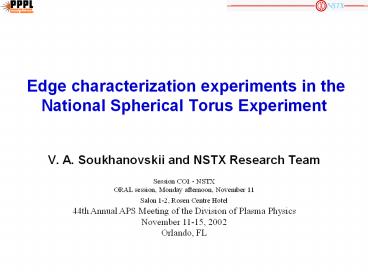Edge characterization experiments in the National Spherical Torus Experiment - PowerPoint PPT Presentation
Title:
Edge characterization experiments in the National Spherical Torus Experiment
Description:
44th Annual APS Meeting of the Division of Plasma Physics. November 11-15, 2002. Orlando, FL ... Source of fueling is gas injection and recycling, NBI source small ... – PowerPoint PPT presentation
Number of Views:48
Avg rating:3.0/5.0
Title: Edge characterization experiments in the National Spherical Torus Experiment
1
Edge characterization experiments in
theNational Spherical Torus Experiment
- V. A. Soukhanovskii and NSTX Research Team
Session CO1 - NSTX ORAL session, Monday
afternoon, November 11 Salon 1-2, Rosen Centre
Hotel 44th Annual APS Meeting of the Division of
Plasma Physics November 11-15, 2002 Orlando, FL
2
Acknowledgements
- R. Maingi, C. Bush (ORNL)
- S. Paul, H. W. Kugel, M. Bell, R. Bell, D.
Johnson, R. Kaita, - S. Kaye, B. LeBlanc, D. Mueller, A. L. Roquemore,
- C. H. Skinner (PPPL)
- R. Raman (University of Washington)
- Pigarov, J. Boedo, S. Krasheninnikov (UCSD)
- G. D. Porter, M. E. Rensink, N. Wolf, C. Lasnier
(LLNL)
Details are in the posters! NSTX poster session
Session GP1, Tuesday afternoon, November 12
Grand Ballroom CDE, Rosen Centre Hotel
3
Edge characterization experiments in NSTX
- Study dependence of edge conditions on heating
power and density - Model edge power and particle flows with UEDGE
2D fluid code
- Diagnostics
- 20-pt MPTS
- Da filtered 1-D CCD cameras
- IRTV (heat profiles)
- Divertor bolometry
- Neutral pressure gauges
- Spectroscopy
- Fast reciprocating probe
4
LSN L-mode and H-mode plasmas with input power
scan
5
Global particle balance indicate pumping walls
- dN/dt is 20 Torr l / s
- NBI rate is 2 - 4 Torr l / s
- HFS gas rate 50 Torr l / s
- Net result - wall pumping
- Frequently observe density rise in LSN and DND
plasmas - Source of fueling is gas injection and
recycling, NBI source small - LFS fueling only wall degassing, LFSHFS
fueling wall pumping - Where is the recycling source?
6
Gas fueling efficiencies are 0.1 - 0.25 (low)
- Gas fueling efficiency weakly depends on density
in one discharge - Variability between discharges is due to wall
conditions - NBI fueling efficiency FE 0.9 (high)
- Core fueling by impurities insignificant
- Poloidal location of fueling is unimportant in
L-mode plasmas - Fueling efficiency does not depend on gas inj.
rate
or
- Fueling efficiency
7
Observations of wall and divertor recycling
- Da?brightness
- Similar on inner wall in L- and H-mode at medium
density - Increases with heating power in outer and inner
divertor - Similar in 2 MW L- and H-modes in inner divertor
- Higher in 2 MW L- vs H-mode in outer divertor
- Factor of 3 - 6 higher in inner divertor vs
outer divertor
8
Zeff scales with NBI power in H-mode similar for
same input power L- and H-modes
- Main impurities carbon and
- oxygen
- Similar levels of impurities in LSN and DNS
plasmas - No accumulation observed
9
High fraction (0.5 - 0.75) of heat power flows
into divertor in L- and H-modes Higher outer
divertor heat flux in L-mode vs H-mode
R. Maingi (ORNL)
10
Outer divertor Peak Heat flux increases
non-linearly with heating power
R. Maingi (ORNL)
11
UEDGE convective transport in L-mode SOL?
- UEDGE modeling
- Separatrix position from EFIT challenged
- Transport
- Nearly matched heat flux profile, edge Te and
ne profiles, particle balance, midplane neutral
pressure - Da?divertor in-out asymmetry not matched due to
uncertainties related to HFS gas injection and
calibration
A. Pigarov (UCSD)
12
Summary
- Analysis of fueling, particle sources and sinks
indicate - need for advanced fueling schemes and active
density control - Divertor heat flux lt 10 MW/m is adequately
handled at present. Additional means will be
needed for t gt 1 s discharges - Divertor detachment has not been clearly
observed. High recycling regime is likely at
present - UEDGE modeling of L-mode points to highly
convective - transport in SOL
- Near future improvements
- - New HFS gas injector with 150 torr l / s
rate - - Supersonic gas nozzle injector under
development - - Low velocity pellet injector to be mounted
in FY03 - - Density feedback control system
2
13
Highest peak heat flux observed 10 MW/m2
R. Maingi (ORNL)































